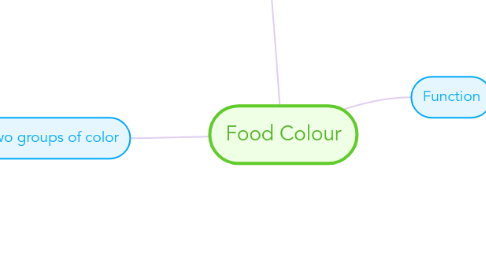
1. What is color additive?
1.1. Any die, pigment or substance which when added or applied to food, drug or cosmetic is capable to impart color.
2. Two groups of color
2.1. Natural color
2.1.1. Exempt color additives- exempt from certification process
2.1.2. Pigments derived from animal, vegetables and mineral sources
2.1.3. Example
2.1.3.1. Turmeric:
2.1.3.1.1. Lemon yellow color
2.1.3.1.2. used: curry and bakery
2.1.3.1.3. Main coloring pigment: Curcumin- good heat and acid stability but sensitive to light.
2.1.3.2. Paprika
2.1.3.2.1. Orange red color
2.1.3.2.2. Used: meats, soups, sauces and snacks.
2.1.3.2.3. Main coloring pigment: capsanthin, capsorubin and beta carotene.
2.1.3.2.4. Fairly stable to heat and light
2.1.3.3. Anthocyanins
2.1.3.3.1. Red at low pH to brownish green at high pH
2.1.3.3.2. Used: beverages, sugar confectionary, fruit preparations
2.1.3.3.3. Fairly stable to heat and light.
2.1.3.4. Annato
2.1.3.4.1. Yellow to red color
2.1.3.4.2. Used: Dairy product due to water solubility
2.1.3.4.3. Strong antioxidative property
2.1.3.4.4. Unstable to light and oxygen
2.1.4. Advantages
2.1.4.1. Oil soluble- well suited for high fat, low moisture foods.
2.1.4.2. Provide transparent color to liquid and oil based products
2.1.4.3. Neutraceutical value- carotenoids and anthocyanins
2.1.5. Disadvantages
2.1.5.1. Instability sensitive to light and heat exposure
2.1.5.2. Not available in certain colors
2.1.5.3. Need higher concentration to obtain the same tint.
2.1.5.4. Objectionable off flavors and off odors
2.1.5.5. Cost
2.2. Synthetic color
2.2.1. Certified color- man-made and have been assigned an FD&c number
2.2.2. Example
2.2.2.1. FD&C blue No 1
2.2.2.2. FD&C Blue No 2
2.2.2.3. FD&C Red No 40
2.2.2.4. FD&C Green No 3
2.2.2.5. FD&C Yellow No 5
2.2.2.6. FD&C Yellow No 6
2.2.2.7. Orange B
2.2.2.8. Citrus No 2
2.3. Advantage
2.3.1. More economical
2.3.2. Easily produce uniform, intense color
2.3.3. Stand up to heat, light, pH and other factors
2.3.4. Do not add off-flavors
2.4. Water soluble dyes
2.4.1. dissolve in water and manufactured as powder, granule or liquid
2.4.2. Application: aqueous beverages, dry mixes, confections, dairy product, noodle products
2.5. Lakes
2.5.1. water soluble FD&C dyes that are combined with insoluble material/ substrate
2.5.2. Base is aluminium hydroxide, aluminiun cation serve as precipitant, color adsorbs onto the surface of aluminium hydroxide.
2.5.3. Impart color by dispersing into the medium
2.5.4. Application
2.5.4.1. Chewing gum
2.5.4.1.1. Disperse lake into gum matrix provides homogenous coloration
2.5.4.1.2. Color locked inside the gum matrix, instead of leaching out into the consumer saliva
2.5.4.2. Fats based products

